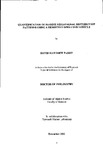QUANTIFICATION OF MARINE MEGAFAUNAL DISTRIBUTION PATTERNS USING A REMOTELY OPERATED VEHICLE
| dc.contributor.author | PARRY, DAVID MATTHEW | |
| dc.contributor.other | Faculty of Science and Engineering | en_US |
| dc.date.accessioned | 2013-09-16T09:45:13Z | |
| dc.date.available | 2013-09-16T09:45:13Z | |
| dc.date.issued | 2002 | |
| dc.identifier | NOT AVAILABLE | en_US |
| dc.identifier.uri | http://hdl.handle.net/10026.1/1733 | |
| dc.description.abstract |
This thesis documents the development and application of the Automated Benthic Image Scaling System (ABISS), a novel structured lighting array for calculating image scale, accounting for perspective, to allow quantitative non-destructive megafaunal sampling using observations from a Remotely Operated Vehicle (ROV). Megafauna are important components of marine soft sediment assemblages that influence the composition of the associated assemblage and the flux of energy across the sediment-water interface, by altering the physical and chemical characteristics of the sediment during bioturbation. However, megafaunal species are not sampled adequately using traditional techniques. Megafaunal abundance estimates derived from ROV observations were validated against those derived from direct diver observations and results suggested that data were in close agreement. To quantify spatial variation of the megafaunal assemblage, spatially referenced images were collected with a maximum sample separation of 400 m within a broader area of homogeneous sediment in Plymouth Sound (United Kingdom) during May 2000 and March 2001. Results demonstrated that the spatial distribution of the megafaunal assemblage was neither uniform nor stable temporally. A hierarchy of spatial structure was detected, whereby, patches with minimum radius between 123-163 m were nested within patches up to 400 m radius. To assess the megafaunal contribution to endobenthic biomass, the population size structure and biomass of the dominant megafaunal bivalve Lutraria lutraria was estimated from measurements of the siphon tips. Results indicated that the population size structure was stable between years despite significant differences in abundance. In addition, L lutraria contributed approximately 90% of the endobenthic biomass, indicating that traditional assessment of benthic biomass by consideration of macrofaunal samples alone will underestimate severely the biomass and respiration of the entire endobentic assemblage. Novel techniques of quantifying the spatial distribution of megafaunal assemblages presented in this thesis offer ways forward to address how variation of megafaunal spatial structure affects macrofaunal assemblage structure, and to discuss the application of remote imaging to map and predict quantitatively the conservation value of subtidal soft sediments. | en_US |
| dc.description.sponsorship | Plymouth Marine Laboratory | en_US |
| dc.language.iso | en | en_US |
| dc.publisher | University of Plymouth | en_US |
| dc.title | QUANTIFICATION OF MARINE MEGAFAUNAL DISTRIBUTION PATTERNS USING A REMOTELY OPERATED VEHICLE | en_US |
| dc.type | Thesis | |
| plymouth.version | Full version | en_US |
| dc.identifier.doi | http://dx.doi.org/10.24382/4672 |
Files in this item
This item appears in the following Collection(s)
-
01 Research Theses Main Collection
Research Theses Main


